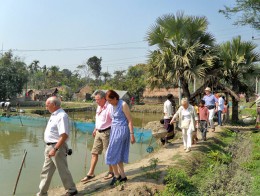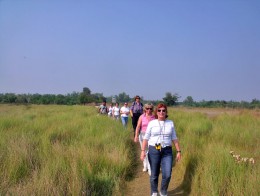Lalbagh Fort
Lalbagh Fort is an incomplete Mughal palace fortress at Dhaka on the river Buriganga. The river has now gone further south and flows at quite a distance from the fort. The construction of the fort was commenced in 1678 AD by Prince Muhammad Azam and was left unfinished since 1684. At the centre of the fort stands the Tomb of Pari Bibi, the beloved daughter of Shaista Khan. On the western side of the tomb stands the Mosque and the Diwaan-e-aam along with the hummam khana is in the east. The fort has a huge tank and residence for the soldiers and officials in the inner side of the southern wall.
Star Mosque
Star Mosque is situated in Abdul Khairat Road, Armanitola, in the old part of Dhaka City. Mirza Golam Pir built a three domed mosque in the 19th Century. In 1926 a local businessman named Alijan Bepari added a verandah to the mosque, and even later in the 1987, Bangladesh Government added two more domes with it making a five domed mosque. Star decoration on its domes gave it such a name.
Armenian Church
Situated in the present day Armanitola of the old part of Dhaka, it is a church established in 1781 by the Armenian community who came to Dhaka in 17th Century to trade with jute and salt. Though the community started moving off the region since the beginning of British rule and disappeared by the early of 20th Century, but the church is still in use by local Christian community.
Rickshaw
Rickshaw is one of the principal means of transport in the urban areas of Bangladesh. It was first introduced in Japan in the early twentieth century. European jute exporters living in Narayanganj and Netrokona had first imported cycle rickshaw from Calcutta in 1938 for their personal use. Only 37 rickshaws were there in Dhaka in 1941, but now the city has about 600,000 rickshaws. Apart from its vehicular value, it is one of the fascinating tourist attractions of Dhaka.
Curzon Hall
This structure was built in 1904. Meant to be a town hall and was named after Lord Curzon, the then British Viceroy in India. It was used as such till 1911, when the partition of Bengal was annulled. Following the annulment of partition in 1911 it was used as a premise of Dhaka College, and after the establishment of Dhaka University in 1921, became part of the university's science section and continues as such.
The building has a happy blend of European and Mughal elements, particularly noticeable in the projecting facade in the north which has both horse-shoe and cusped arches. The style combined traditional art with modern technology and functions and favoured Mughal forms such as arches and domes, believed to have entered the Islamic world from the west.
Liberation War Museum
Liberation War Museum collects preserves and displays the objects, artifacts and all other materials related to the War of Liberation of Bangladesh against Pakistan in 1971. It was inaugurated on 22 March 1996 at 5 Segun Bagicha, Dhaka in a two-storied old-sty1e building. There is an eternal flame at the entrance.
The museum has six galleries the first of which demonstrates the Customs & Traditions of Bengal as well as the struggle against colonial control. The second gallery presents a chronicle of the period of the Pakistani rule from 1947 and especially, the political, economic and cultural oppression on the people of East Pakistan and the resistance against it. The third gallery shows relics of the non-cooperation movement of March 1971, the genocide and resistance, declaration of independence and the plight of the Refugees. The three galleries on the second floor display documents and materials that show various aspects of resistance by the people of East Pakistan, international solidarity to them, the killing of intellectuals by Pakistan Army and its collaborators, and the victory of the Bengali people.
National Museum
The Bangladesh National Museum preserves and displays the cultural property and heritage, as well as specimens of natural history of Bangladesh. It is located at Shahbagh, Dhaka. The museum is well organized. Itwas formally inaugurated on March 20, 1913.
The four-storied building of the museum has 43 galleries on a total floor space of 238,000 square feet. It has a collected 82,475 objects. The most significant objects are ancient petrified wood (2.5 million years old) collected from lalmai and mainamati; blackstone Naga Darwaza (serpent doorway) of 10th-11th century collected from Bangarh, Dinajpur; pieces of atom bombs blasted in Hiroshima and Nagasaki, Japan in 1945; mat made of ivory; objects of the Liberation War of Bangladesh; objects used by the martyrs of the language movement; muslin of Dhaka; items of folk art and crafts; coins of emperor Sher Shah; terracotta plaques; sculptures and collection of contemporary art including various types of statues.




